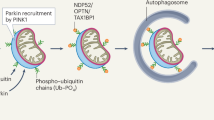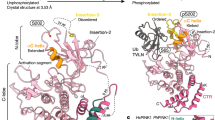Abstract
In mice, _targeted deletion of the serine protease HtrA2 (also known as Omi) causes mitochondrial dysfunction leading to a neurodegenerative disorder with parkinsonian features. In humans, point mutations in HtrA2 are a susceptibility factor for Parkinson's disease (PARK13 locus). Mutations in PINK1, a putative mitochondrial protein kinase, are associated with the PARK6 autosomal recessive locus for susceptibility to early-onset Parkinson's disease. Here we determine that HtrA2 interacts with PINK1 and that both are components of the same stress-sensing pathway. HtrA2 is phosphorylated on activation of the p38 pathway, occurring in a PINK1-dependent manner at a residue adjacent to a position found mutated in patients with Parkinson's disease. HtrA2 phosphorylation is decreased in brains of patients with Parkinson's disease carrying mutations in PINK1. We suggest that PINK1-dependent phosphorylation of HtrA2 might modulate its proteolytic activity, thereby contributing to an increased resistance of cells to mitochondrial stress.
This is a preview of subscription content, access via your institution
Access options
Subscribe to this journal
Receive 12 print issues and online access
We are sorry, but there is no personal subscription option available for your country.
Buy this article
- Purchase on SpringerLink
- Instant access to full article PDF
Prices may be subject to local taxes which are calculated during checkout





Similar content being viewed by others
References
Faccio, L. et al. Characterization of a novel human serine protease that has extensive homology to bacterial heat shock endoprotease HtrA and is regulated by kidney ischemia. J. Biol. Chem. 275, 2581–2588 (2000).
Gray, C. W. et al. Characterization of human HtrA2, a novel serine protease involved in the mammalian cellular stress response. Eur. J. Biochem. 267, 5699–5710 (2000).
Hegde, R. et al. Identification of Omi/HtrA2 as a mitochondrial apoptotic serine protease that disrupts inhibitor of apoptosis protein–caspase interaction. J. Biol. Chem. 277, 432–438 (2002).
Martins, L. M. et al. The serine protease Omi/HtrA2 regulates apoptosis by binding XIAP through a reaper-like motif. J. Biol. Chem. 277, 439–444 (2002).
Suzuki, Y. et al. A serine protease, HtrA2, is released from the mitochondria and interacts with XIAP, inducing cell death. Mol. Cell 8, 613–621 (2001).
Verhagen, A. M. et al. HtrA2 promotes cell death through its serine protease activity and its ability to antagonize inhibitor of apoptosis proteins. J. Biol. Chem. 277, 445–454 (2002).
Martins, L. M. et al. Binding specificity and regulation of the serine protease and PDZ domains of HtrA2/Omi. J. Biol. Chem. 278, 49417–49427 (2003).
Yang, Q. H., Church-Hajduk, R., Ren, J., Newton, M. L. & Du, C. Omi/HtrA2 catalytic cleavage of inhibitor of apoptosis (IAP) irreversibly inactivates IAPs and facilitates caspase activity in apoptosis. Genes Dev. 17, 1487–1496 (2003).
Jones, J. M. et al. Loss of Omi mitochondrial protease activity causes the neuromuscular disorder of mnd2 mutant mice. Nature 425, 721–727 (2003).
Martins, L. M. et al. Neuroprotective role of the Reaper-related serine protease HtrA2/Omi revealed by _targeted deletion in mice. Mol. Cell. Biol. 24, 9848–9862 (2004).
Spiess, C., Beil, A. & Ehrmann, M. A temperature-dependent switch from chaperone to protease in a widely conserved heat shock protein. Cell 97, 339–347 (1999).
Walsh, N. P., Alba, B. M., Bose, B., Gross, C. A. & Sauer, R. T. OMP peptide signals initiate the envelope-stress response by activating DegS protease via relief of inhibition mediated by its PDZ domain. Cell 113, 61–71 (2003).
Strauss, K. M. et al. Loss of function mutations in the gene encoding Omi/HtrA2 in Parkinson's disease. Hum. Mol. Genet. 14, 2099–2111 (2005).
Cilenti, L. et al. Regulation of HAX-1 anti-apoptotic protein by Omi/HtrA2 protease during cell death. J. Biol. Chem. 279, 50295–50301 (2004).
Valente, E. M. et al. Hereditary early-onset Parkinson's disease caused by mutations in PINK1. Science 304, 1158–1160 (2004).
Bonifati, V. et al. Early-onset parkinsonism associated with PINK1 mutations: frequency, genotypes, and phenotypes. Neurology 65, 87–95 (2005).
Hatano, Y. et al. Novel PINK1 mutations in early-onset parkinsonism. Ann. Neurol. 56, 424–427 (2004).
Li, Y. et al. Clinicogenetic study of PINK1 mutations in autosomal recessive early-onset parkinsonism. Neurology 64, 1955–1957 (2005).
Rogaeva, E. et al. Analysis of the PINK1 gene in a large cohort of cases with Parkinson disease. Arch. Neurol. 61, 1898–1904 (2004).
Rohe, C. F. et al. Homozygous PINK1 C-terminus mutation causing early-onset parkinsonism. Ann. Neurol. 56, 427–431 (2004).
Obenauer, J. C., Cantley, L. C. & Yaffe, M. B. Scansite 2.0: Proteome-wide prediction of cell signaling interactions using short sequence motifs. Nucleic Acids Res. 31, 3635–3641 (2003).
Kuma, Y. et al. BIRB796 inhibits all p38 MAPK isoforms in vitro and in vivo. J. Biol. Chem. 280, 19472–19479 (2005).
Chandel, N. S. et al. Mitochondrial reactive oxygen species trigger hypoxia-induced transcription. Proc. Natl Acad. Sci. USA 95, 11715–11720 (1998).
Li, W. et al. Structural insights into the pro-apoptotic function of mitochondrial serine protease HtrA2/Omi. Nature Struct. Biol. 9, 436–441 (2002).
Wilken, C., Kitzing, K., Kurzbauer, R., Ehrmann, M. & Clausen, T. Crystal structure of the DegS stress sensor: How a PDZ domain recognizes misfolded protein and activates a protease. Cell 117, 483–494 (2004).
Greenamyre, J. T. & Hastings, T. G. Biomedicine. Parkinson's—divergent causes, convergent mechanisms. Science 304, 1120–1122 (2004).
Paisan-Ruiz, C. et al. Cloning of the gene containing mutations that cause PARK8-linked Parkinson's disease. Neuron 44, 595–600 (2004).
Ramirez, A. et al. Hereditary parkinsonism with dementia is caused by mutations in ATP13A2, encoding a lysosomal type 5 P-type ATPase. Nature Genet. 38, 1184–1191 (2006).
Zimprich, A. et al. Mutations in LRRK2 cause autosomal-dominant parkinsonism with pleomorphic pathology. Neuron 44, 601–607 (2004).
Beilina, A. et al. Mutations in PTEN-induced putative kinase 1 associated with recessive parkinsonism have differential effects on protein stability. Proc. Natl Acad. Sci. USA 102, 5703–5708 (2005).
Silvestri, L. et al. Mitochondrial import and enzymatic activity of PINK1 mutants associated to recessive parkinsonism. Hum. Mol. Genet. 14, 3477–3492 (2005).
Sim, C. H. et al. C-terminal truncation and Parkinson's disease-associated mutations down-regulate the protein serine/threonine kinase activity of PTEN-induced kinase-1. Hum. Mol. Genet. 15, 3251–3262 (2006).
Harper, S. J. & Wilkie, N. MAPKs: new _targets for neurodegeneration. Expert Opin. Ther. _targets 7, 187–200 (2003).
Pridgeon, J. W., Olzmann, J. A., Chin, L. S. & Li, L. PINK1 protects against oxidative stress by phosphorylating mitochondrial chaperone TRAP1. PLOS Biol. 5, e172 (2007).
Young, J. C. & Hartl, F. U. A stress sensor for the bacterial periplasm. Cell 113, 1–2 (2003).
Abou-Sleiman, P. M. et al. A heterozygous effect for PINK1 mutations in Parkinson's disease? Ann. Neurol. 60, 414–419 (2006).
Gandhi, S. et al. PINK1 protein in normal human brain and Parkinson's disease. Brain 129, 1720–1731 (2006).
Vyas, S. et al. Differentiation-dependent sensitivity to apoptogenic factors in PC12 cells. J. Biol. Chem. 279, 30983–30993 (2004).
Evan, G. I., Lewis, G. K., Ramsay, G. & Bishop, J. M. Isolation of monoclonal antibodies specific for human c-myc proto-oncogene product. Mol. Cell. Biol. 5, 3610–3616 (1985).
Garner, A. P., Weston, C. R., Todd, D. E., Balmanno, K. & Cook, S. J. ΔMEKK3:ER* activation induces a p38α/β2-dependent cell cycle arrest at the G2 checkpoint. Oncogene 21, 8089–8104 (2002).
Rytomaa, M., Lehmann, K. & Downward, J. Matrix detachment induces caspase-dependent cytochrome c release from mitochondria: inhibition by PKB/Akt but not Raf signalling. Oncogene 19, 4461–4468 (2000).
Abraham, V. C., Taylor, D. L. & Haskins, J. R. High content screening applied to large-scale cell biology. Trends Biotechnol. 22, 15–22 (2004).
Acknowledgements
We thank D. Hancock for valuable advice, N. Totty for mass spectrometric analysis, V. Dawson, NWW, RJH and ED were supported by the MRC SG0400000 grant and the PDS NWW was supported by the W-T-CRF. G. Schiavo, A. Schulze and K. Dimmer for materials, S. Loh for help with the Cellomics KSR microscopy system, and A. Borg and T. Simmonds for assistance in the preparation of recombinant HtrA2. K.K. was funded by a PhD studentship from Boehringer Ingelheim Fonds. This work was supported by Cancer Research UK.
Author information
Authors and Affiliations
Corresponding authors
Supplementary information
Supplementary Information
Supplementary Figures 1, 2, 3, 4, 5, Supplementary Materials and Methods (PDF 1947 kb)
Rights and permissions
About this article
Cite this article
Plun-Favreau, H., Klupsch, K., Moisoi, N. et al. The mitochondrial protease HtrA2 is regulated by Parkinson's disease-associated kinase PINK1. Nat Cell Biol 9, 1243–1252 (2007). https://doi.org/10.1038/ncb1644
Received:
Accepted:
Published:
Issue Date:
DOI: https://doi.org/10.1038/ncb1644
This article is cited by
-
Signaling pathways in Parkinson’s disease: molecular mechanisms and therapeutic interventions
Signal Transduction and _targeted Therapy (2023)
-
_targeting Mitochondria as a Therapeutic Approach for Parkinson’s Disease
Cellular and Molecular Neurobiology (2023)
-
Apoptotic proteins with non-apoptotic activity: expression and function in cancer
Apoptosis (2023)
-
Regulation of Neurodegeneration-associated Protein Fragments by the N-degron Pathways
Neurotoxicity Research (2022)
-
Dusp26 phosphatase regulates mitochondrial respiration and oxidative stress and protects neuronal cell death
Cellular and Molecular Life Sciences (2022)



